Wide attacking runs and crosses
The session is particularly about the accuracy of crossing and in all parts of the session the crosser is given more than one target to aim for. In the modern game, with so many teams now looking to get overloads in the central midfield areas, it has become ever more important to be competitive and efficient in the wide areas of the pitch. Although this session leads into crossing and finishing, it is also about the timing of the runs.

| Area | Just over half a pitch |
| Equipment | Balls, bibs, cones, mannequins, 4 goals |
| No. of Players | Up to 20 players + 4 goalkeepers |
| Session Time |
Passing drill: 4mins, Progression: 4mins, Attacking the flanks: 15mins, Fast attacks: 20mins, 12v12 game: 20mins |
This training session encourages players to make attacking runs in wide areas of the pitch leading to crosses into the penalty area.
The session is particularly about the accuracy of crossing and in all parts of the session the crosser is given more than one target to aim for.
In the modern game, with so many teams now looking to get overloads in the central midfield areas, it has become ever more important to be competitive and efficient in the wide areas of the pitch. Although this session leads into crossing and finishing, it is also about the timing of the runs.
I would tend to run this session regularly, particularly as many of my teams have often played with wingers. It’s also relevant to the modern game because of what we expect of today’s attacking full backs.
I would also run this session before we played against opponents where we felt we could benefit from getting overloads or space in the wide area.
PASSING DRILL
We set up a playing area of 44x44 yards with a 10-yard midfield box in the centre. We’re using 10 outfield players, with a back four in each end zone and two midfielders in the central box.
Play starts with the ball being played across the back four before being passed into the centre zone by a centre back. The highest midfielder receives and lays it back to the deeper midfielder to play wide.
A full back makes a well-timed run to receive the pass and then plays it on to one of the centre backs in the opposite end zone, as shown [1a].
1a
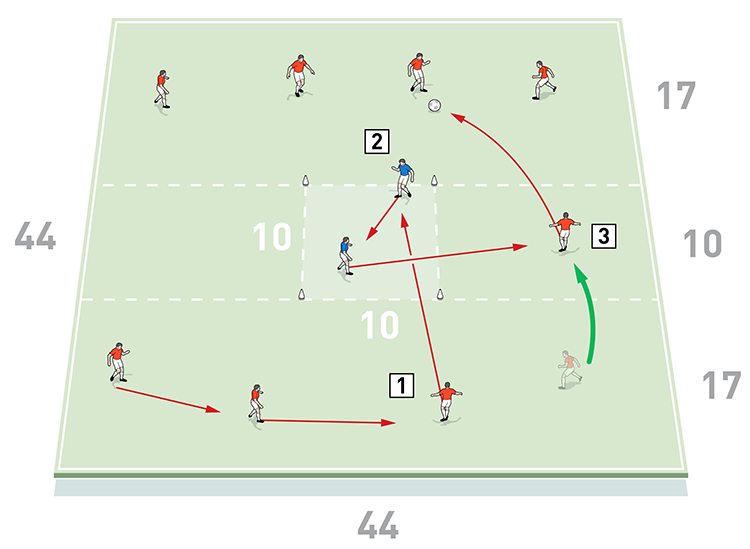
2. The highest of the rotating midfielders receives and lays the ball back to the deeper midfielder
3. The deeper midfielder plays the ball wide to the right back, who makes a well-timed run to receive and passes it into the opposite end zone
The receiving centre back passes to the other centre back, who receives and plays a pass to the highest midfielder and the drill repeats in the opposite direction, as shown [1b].
1b

2. The centre back receives and passes to the highest midfielder, who lays the ball back to the other midfielder
3. The deeper midfielder plays the ball to the full back, who makes a well-timed run to receive and passes it into the opposite end zone
We play for four minutes. After two minutes we go in the opposite direction and play up the other side of the playing area.
We set up as before in a playing area of 44x44 yards with a 10-yard box in the centre. Again, we’re using 10 outfield players, with a back four in each end zone and two midfielders in the central box. This drill uses the same principles as before but with different movement across the back four.
Here we are looking to develop the passing range and imagination of the players. The ball can now travel across back four more frequently, as shown [2a], and the forward pass to the higher central midfielder can come from any one of the back four players. Also the wide player’s pass into the end players can now go to any of the back four, as shown [2b].
2a
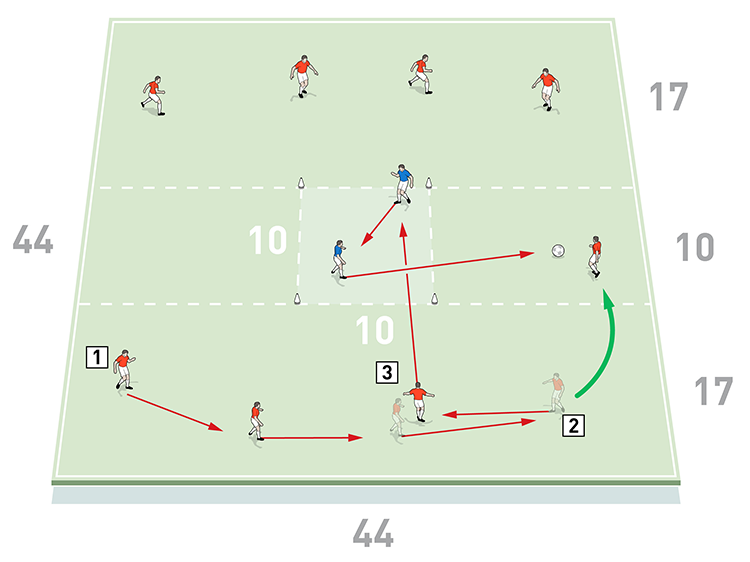
2. The ball can now travel across the back four more frequently. Here the full back returns it to the centre back
3. Now the forward pass to the higher midfielder can come from any one of the back four players
2b

We play for four minutes. After two minutes we go in the opposite direction and play up the other side of the playing area.
ATTACKING THE FLANKS
We set up a goal and a goalkeeper in the penalty area with an 18x15 yard crossing zone marked out next to the penalty area. A second 18x15 yard possession box is marked out on the same flank, as shown [3].
3
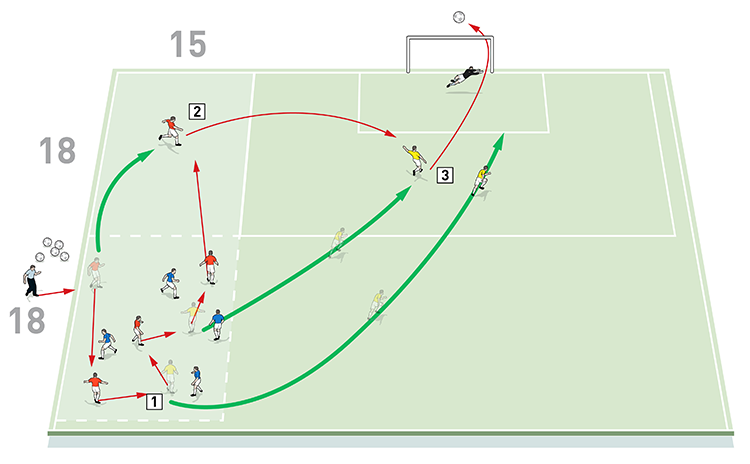
2. If the possession team makes five passes, one player is released into the crossing zone to receive a pass and he has two touches to cross
3. The two yellow floaters double as strikers. They make runs into the penalty area to finish from the cross
We’re using 10 outfield players, split into two teams of four who are two-touch, plus two one-touch yellow neutrals who play for the team in possession and who double up as running strikers.
We play a 4v4 game in the possession box and if the passing team manages to string five or more passes together with the help of the two neutrals, then one of their players is released to run into the crossing zone to receive a pass.
The receiving player has two touches to cross the ball to one of the neutral running strikers, who both sprint into the penalty area and attempt to finish with a shot on goal.
If the pressing team wins the ball in the possession box, they can release a player into the crossing zone after two passes but if they are unable to do so, they must make five passes before they have a second opportunity to play a release pass.
We rotate the neutrals every three crosses. We also set up at the other end of the pitch to run the same activity, in order to give players the experience of crossing from both sides.
FAST ATTACKS
We mark out a 25x30-yard possession box over the halfway line, as shown [4]. We’re using 18 outfield players, split into two teams of seven and a neutral front four who play for the possession team.
4
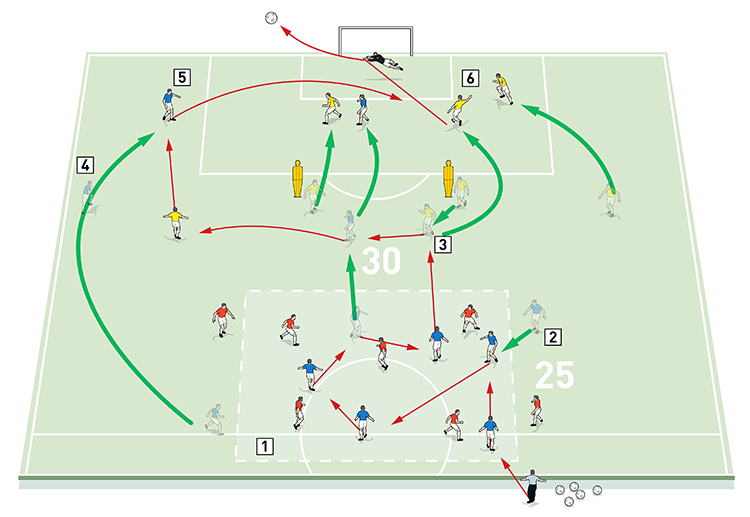
2. Each team has a pair of two-touch support players to the side of the box who can step in to help when their team is on the ball
3. After making five passes the team can pass to the neutral striker. They also release one breakout player who receives a layoff from the yellow striker and passes to the neutral winger
4. At the same time as the midfielder breaks out of the possession box, one of the support players can also join the attack by making an overlapping run down the wing
5. The overlapping support player receives a pass from the yellow winger and crosses into the penalty area
6. The neutral attackers and the one breakout player can make attacking runs to meet the cross and finish on goal
Each of the teams has five players in the possession box who are three-touch, and two supporting players on the outside of the possession box who are limited to just two touches.
The coach starts and restarts play by passing in to the possession box. The receiving team passes the ball to keep possession in a 5v5, aided by their supporting team mates on the outside who can step into the box to help when their team has the ball.
If the possession team can string five or more passes together, they can pass out to the neutral striker and one of their players is released from the possession box to receive the ball back from the neutral striker and play it out to the neutral winger.
One of the possession team’s supporting players can join the attack by making an overlapping run down the wing to receive a pass and cross into the penalty area for one of the neutral attackers to finish on goal. The possession player who initially broke out of the box can also make an attacking run to meet the cross.
12v12 GAME
To progress the session into a game, we set up on half a pitch with two goals at each end. We’re using 20 outfield players and four goalkeepers, split into two teams of 12 – each team has two goalkeepers.
We set up the teams with each playing in a different formation; this is to encourage good movement and to help wide players make good decisions on the flanks.
We play a normal game with one condition imposed: a goal can only be scored from a cross, as shown [5]. Wide players are given plenty of good crossing options, as they can cross into either of the two goals at the end they are attacking.
5
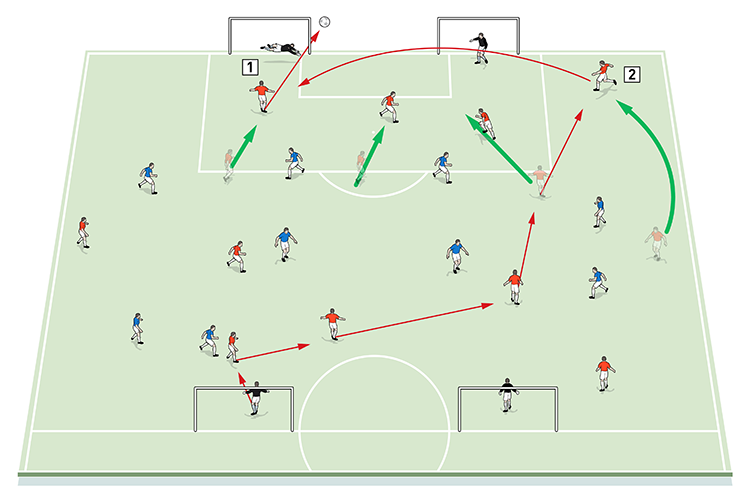
2. Wide players have plenty of options as they can cross into either goal at the end they are attacking
What are the key things to look out for?
We want to see players reading the pass well and attackers making well-timed runs into the penalty area. We also want to see the crosser playing with his head up to be able to see any movement in the box to aim for. Using the correct quality and weight of cross is also key to the success of the session.
What are the typical mistakes players might make and how do I avoid them?
Mistakes that players frequently make include not reading either the game or the pass well enough, going too early, and making badly-timed runs into the box. Coaching the players between drills should help to eradicate this poor decision making.
Editor's Picks
Attacking transitions
Deep runs in the final third
Using the goalkeeper in build-up play
Intensive boxes drill with goals
Penetrating the final third
Creating and finishing
My philosophy
Pressing initiation
Compact team movement
Coaches' Testimonials

Alan Pardew

Arsène Wenger

Brendan Rodgers

Carlos Carvalhal

José Mourinho

Jürgen Klopp

Pep Guardiola

Roy Hodgson

Sir Alex Ferguson

Steven Gerrard
Coaches' Testimonials

Gerald Kearney, Downtown Las Vegas Soccer Club

Paul Butler, Florida, USA

Rick Shields, Springboro, USA

Tony Green, Pierrefonds Titans, Quebec, Canada
Join the world's leading coaches and managers and discover for yourself one of the best kept secrets in coaching. No other training tool on the planet is written or read by the calibre of names you’ll find in Elite Soccer.
In a recent survey 92% of subscribers said Elite Soccer makes them more confident, 89% said it makes them a more effective coach and 91% said it makes them more inspired.
Get Monthly Inspiration
All the latest techniques and approaches
Since 2010 Elite Soccer has given subscribers exclusive insight into the training ground practices of the world’s best coaches. Published in partnership with the League Managers Association we have unparalleled access to the leading lights in the English leagues, as well as a host of international managers.
Elite Soccer exclusively features sessions written by the coaches themselves. There are no observed sessions and no sessions “in the style of”, just first-hand advice delivered direct to you from the coach.









